Peak Gullibility & NYSE 52Wk Highs-Low Ratio Signal Hard Times Are Coming
Bear Markets serve a necessary purpose in the financial markets: to clean up the mess left by the bulls. What kind of mess is that? When the party is financed with other people's money, Mr Bear's clean-up crew has quite a task before them. But modern finance isn't really financed with other people's money. Today, the fuel driving the global markets are dollars (and euros) backed only by the public's gullibility. Washington and Wall Street actually prefer their digital-dollars, backed by the public's ignorance of what proper money is, because physical money place limits on their greed and ambitions. We live in a world where trillions of dollars can be created, and "injected" into the economy with a few effortless keystrokes on a computer.
Before the era of modern computers, when central banking disbursed money where it was needed by armored truck (not the internet), printing a trillion paper dollars in a month's time would have been unimaginable, as there just isn't enough cotton stockpiled in the world for the task. But bankers can go to their local IBM sales representative, or even a Best Buy outlet store, and obtain all the computing power they need to create unlimited quantities of "money", and the means of "injecting" it into their credit-junkies' accounts.
The media makes much of "peak oil." Gold-bugs (a moniker I'm proud to wear) are beginning to think about peak gold and silver. But in August of 2011, the most pressing shortage in the financial market, for the policy makers, is peak gullibility. Every central banker is keenly aware of the fact that their banking system's most critical limitation isn't the number of units of money they can create. For central bankers, there is little difference between a million, a billion or a trillion with trusty lap-top computer at hand. But the nightmare that haunts Doctor Bernanke's sleep at night is a recurring nightmare that his dollar is rapidly becoming an article of ridicule. Once the public becomes aware of that reality, there is no crossing back into the complacent fantasy world of today, that getting out of bed in the morning in exchange for Doctor Bernanke's dollars is worth the effort.
The above forms my big picture view of what is really driving the financial markets from the Dow Jones' last bull market high (October 2007) when central banking was a highly respected institution, to the Dow's real bear market bottom, when central bankers will be universally despised in all 24 global-time zones. For this reason, I * never *believed the Dow's March 2009 bottom was a real bottom in a bear market. In March 2009, none of the inflationary excesses from the Greenspan and Bernanke era were cleansed, in fact, they were monetized!
To this very day, the global financial system still allows the the toxic waste from Congress's mortgage bubble to stand-in for actual reserves at central banks, pension funds and insurance companies. Had March 2009 been a real bear-market bottom, traffic in lower Manhattan would have come to a standstill for years, as Mr Bear contracted every garbage truck in New England to haul away Washington's and Wall Street's putrid garbage created by Greenspan and Bernanke's malfeasance in the financial markets. The credit-default swaps for Greece alone would take a few weeks for Mr Bear to haul away! Mark my words: this bear market isn't over until Mr Bear says it is.
But market psychology is still far from reaching the point where marking-to-market valuation, no matter what the consequence, is demanded by investors, ratings agencies and government regulators. However, everyone's balance sheet, from the glorious to the humble, will be personally inspected for toxicity at the bottom of a massive bear market, and where appropriate, once valued assets will be revalued as worthless. The "policy makers" will do all that is in their power to oppose this, but all they can do is create more money and credit. Unfortunately for them, the day is quickly coming when that scam isn't going to work anymore.
So, bear markets are a process, not a single event. Many things must happen before we see the actual bottom of the 2007-2011 (2000-2011?) bear market. One of the mile-stones we must pass on our journey to the bottom is a revaluation of the stock market. I don't know exactly what that will mean in market losses, however I suspect that our bear market is a worthy contender to take away the heavy-weight crown from the 1929-32 bear market. But it's still too early to dwell on that now, so let's just examine what the market has done this week. First, let's look at some 52Wk Highs - 52Wk Lows Ratios.
Here I've plotted the Dow Jones with the NYSE's 52Wk H-L Ratio. One could profitably spend a few hours studying this chart, noting how the relationships between the Dow Jones and the 52Wk Highs and Lows at the NYSE change over time, in both bull and bear markets. This data is not a tool for day-traders, but investors with a multi-year perspective on the markets, people like me.
In my last article I called for a big drop in the market. I've received a few letters congratulating me on my brilliant call. But the truth is, I've been warning my readers of a big drop in the market since last year, when the peak in this data (upper brown circle) failed to exceed the highs of April 2010. Noting that each successive peak in the NYSE 52Wk H-L ratio was less than its previous peak, we see a classical indication that "liquidity" was draining from the stock market. I have data going back to 1933, and this is one of the most dependable market patterns I've found in my research.
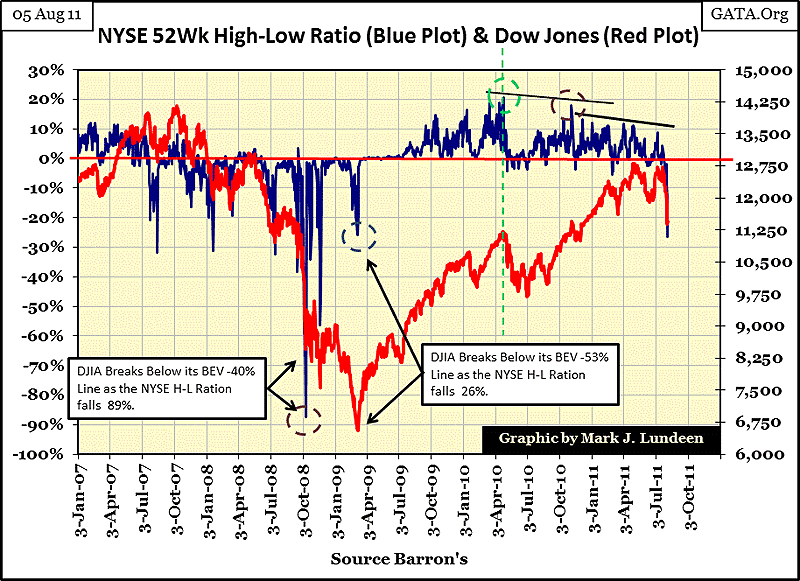
Studying this data during the 2007-09 period is a good indication of what is coming our way. Today the NYSE 52 Wk High/Low Ratio actually fell to the lowest point since 2008, lower than the spike down set at the March 2009 stock market bottom! But in 2009, "liquidity" was flooding * into * the NYSE, since the beginning of 2011, it has been flooding * out of * the stock market.
Mr Bear is going to take the market down in steps. Note how the Dow Jones made its October 2007 all-time high with the ratio at less than 10%, pretty much like our latest high in the Dow on July 7th. Strangely, in the summer of 2007, months before the final high in the Dow, this ratio fell to negative 30% on news that Bear Stearns' money market fund's reserves were mostly illiquid mortgage derivatives. What is strange about this is that the Dow Jones still had another new all-time high (October 2007) up its sleeve. I guess the market did not yet understand the damage Wall Street's derivatives sale force had inflicted on the financial market. When a similar derivative event happens again, and it will, the market will not be so slow to understand the implications.
Soon after the October 2007 high in the Dow Jones, shares trading at the NYSE began transiting downward toward their 52Wk lows in a series of sharp spikes, climaxing in October 2008, as the panic in the stock market peaked. Note that the Dow Jones itself was still five months away from its ultimate low of the move. When the Dow reached its bottom on 09 March 2009, the NYSE 52Wk H-L Ratio made a much smaller downward spike.
This pattern repeated itself, in reverse, during the 2009-2011 advance in the Dow Jones. With the exception of the 1942's -52.2% bear market, during a time when retail investors were as rare as honest central bankers on Wall Street, this has been a firmly established pattern in the stock market.
So what's next? Look at the chart! Once our current down spike finds its bottom, this plot will once again see single-digit positive numbers for short period of time. Expect market "experts" to tell the public that the worst is over. But Mr Bear is just playing with everyone before he takes the plot down again. This should happen several times before the NYSE 52Wk H-L Ratio hits a true crisis low. How can we tell a crisis low from the others? Well, during the crisis low of October 2008, CNBC was providing commercial free airtime to air C-Span coverage of the credit crisis investigation, where Congress was blaming everyone else but themselves for the credit crisis.
I'm not going to predict when, just that we have now entered into a bearish period in the market, one that will be severe enough to justify CNBC to once again provide free airtime to Congress, where they can blame the bear market on the "terror tactics" of Tea Party partisans, such as gold bugs like me, writing articles like this, for internet readers like you. But the last crisis bottom in the NYSE 52Wk H-Ls Ratio marked a bottom in the outflows of liquidity from the stock market. The dollar, and "policy" was still intact after October 2008, but that may not be the case at our next crisis bottom in this ratio. It may be a long time before a profitable entry point appears in the stock market, and this indicator may not provide it. Some decisions are best made on a day to day basis.
Let's look at some other 52Wk H-L ratios. Here is the updated chart for the Dow Jones Total Market Group, the data is based on weekly closing prices. I like this data as it's looking at industry groups, not individual stocks. But the pattern described above still holds! This week, we see the 52Wk H-L Ratio fall to negative 11. That's not bullish!
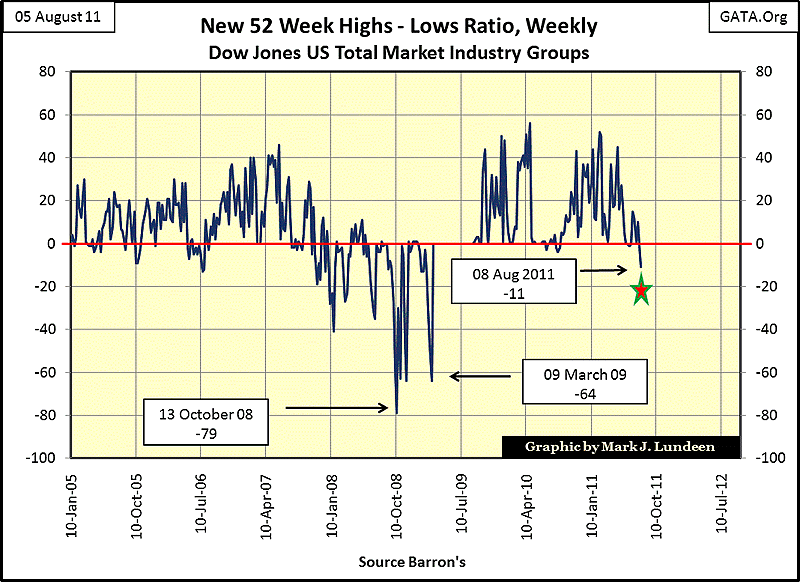
Unlike the NYSE data, where I use published values to construct my plots, I have to calculate my 52Wk Highs and Lows in the Dow Jones Total Market Group data using Excel functions. So what's stopping me from calculating 3-YrHighs and Lows from the data? Nothing, and here it is in the chart below.
Now, the DJTMG's 3-Yr H-L ratio has yet to register a negative number since the credit crisis, and I guess that is a good thing. But what I'm looking at is a pattern of progressively weaker bull markets, from the perspective of 3-Year H-L data. My data starts in 1991, and the 1990s was really a strong market period, with lots of indexes hitting 3 -Yr Highs. After the "high-tech wreck" bottom in 2002, once again the DJTMG's saw lots of new 3-Yr Highs, but the good times didn't last as long as they had in the 1990s, and the 3 year High/Low Ratio peaked at barely over 40 in 2007, while in 1997, the ratio exceeded 60.
Looking at the post-credit crisis bull run, from the perspective of 3-Yr H-Ls, this was a very wimpy advance. It could only manage a one year cluster (see blue rectangle), with a peak barely over 30. There is a message in this: over the past two decades, the "policy makers" have becoming weak, while Mr Bear is becoming strong, and that isn't good for the stock market.
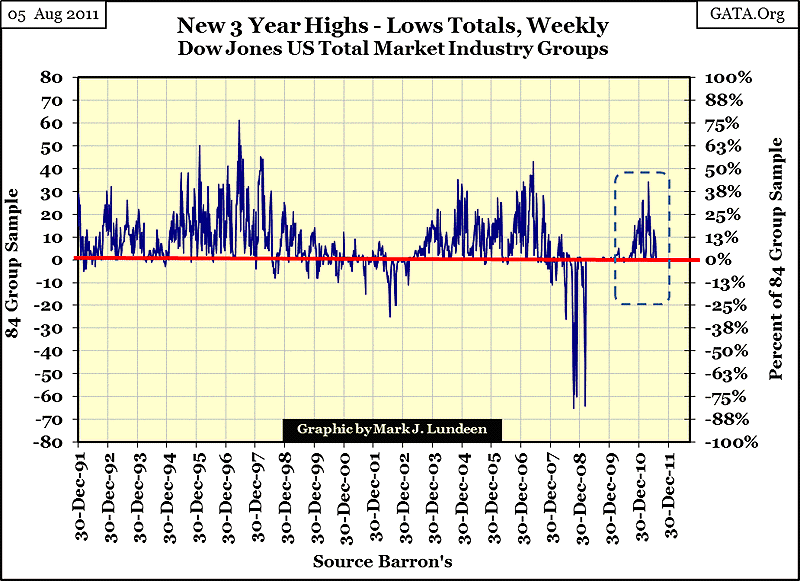
I want to emphasize something: the Dow Jones at the close of 5 August 2011 is down less that 20% from its high of October 2007, and only 11% down from its post-credit crisis highs. Normally even a 20% decline should be no big thing. During the 1980s & 90s, a loss of 20% was more often than not, seen as a buying opportunity in the financial media than a concern of worse to come. But deep-down inside, everyone knows something is terribly wrong with today's financial markets, so the current decline in the Dow is causing a lot of concern in the media, and for good reason! The chart above, plotting the DJTMG's 3-Yr H-Ls, tells us a story of a very weak market, one that could roll-over and die sometime in the next few years, if not in the next twelve months.
We see the same story in the foreign stock indexes I track. Here is the 52Wk H-L data I derive from that series.
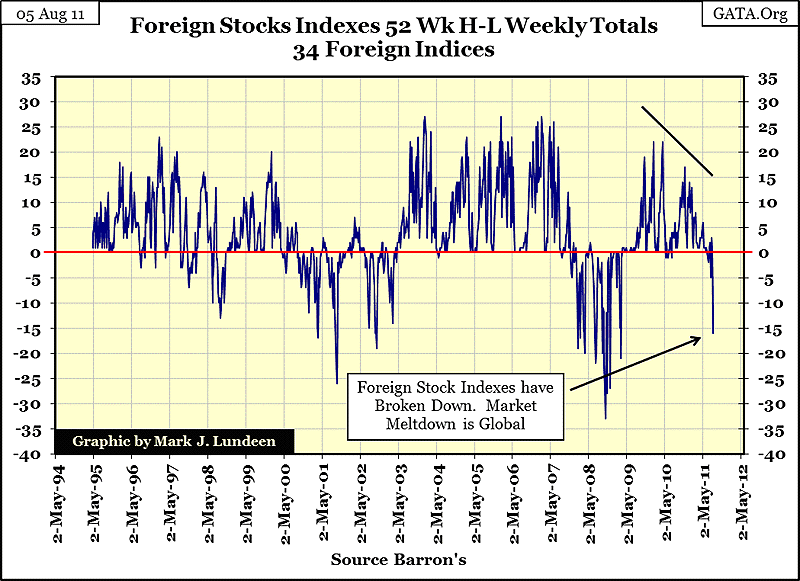
And here is their 3Yr H-L plot. Sorry, I have less than two decades of data, but it's enough to tell the story. Look at the pathetic post-credit crisis performance in the foreign stock markets!
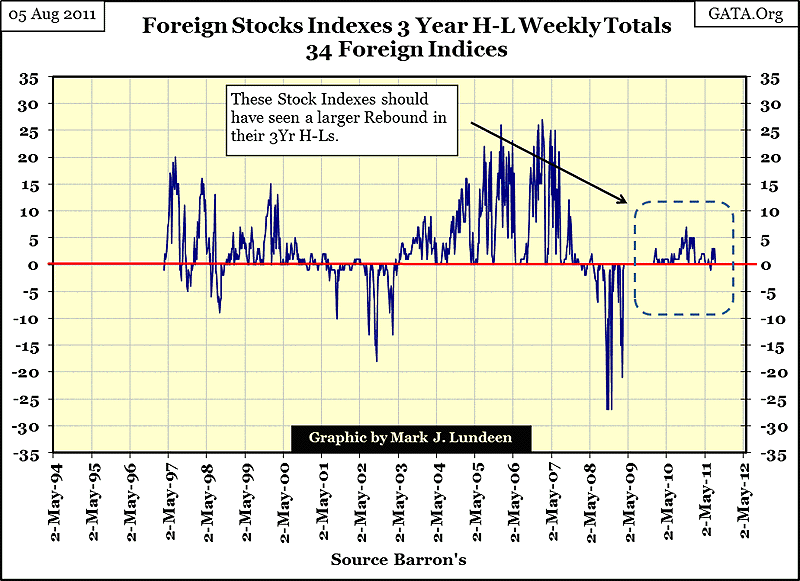
Other than noting that the risks don't compensate the potential rewards in the stock market, globally, there is really nothing good to say about buying stocks at today's prices. That is not to say that in the coming months there won't be good rallies at the NYSE. In fact, we can count on it as traditionally the largest daily advances in market history occur during bear markets, as the chart below clearly illustrates. That's one of the reasons the BIG -40% Bear Markets are so deadly to investors, they don't know they're dancing with Mr Bear, who is always takes great joy in stepping on his partner's toes. He likes the big up days, because they make investors want to get back on the dance floor with Mr Bear again.
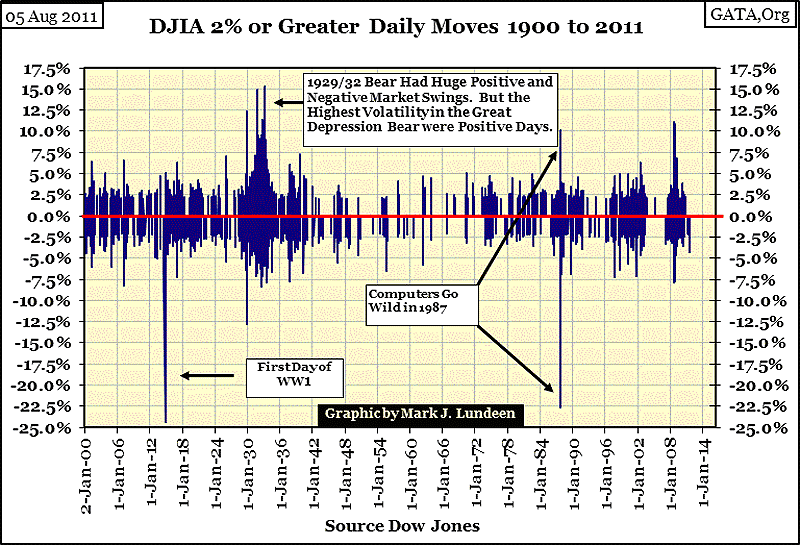
With the exception of miners, and I include copper mining stocks, I can't in good conscience recommend risking capital in the stock market. My hot stock tip of the day? Get the hell out of Dodge while you still can!
[email protected]
















